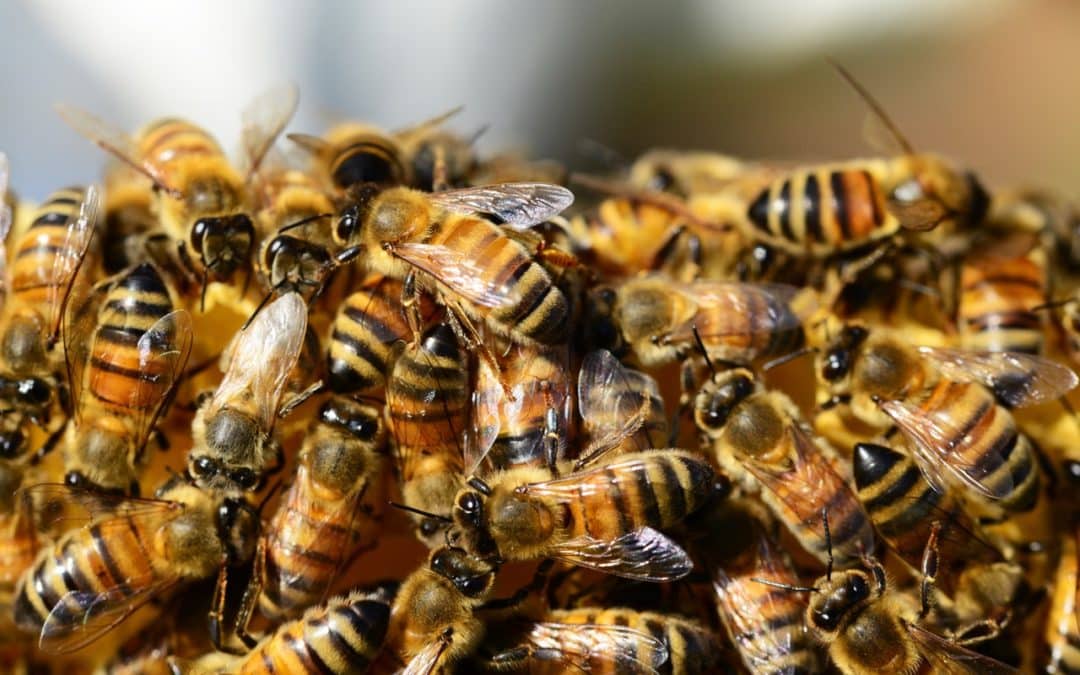Killer bees, also known as Africanized honey bees, have been slowly migrating northward for decades These aggressive hybrids of European and African honey bees first escaped captivity in Brazil in the 1950s and have steadily expanded their range since. While killer bees have yet to permanently establish themselves in North Carolina, temporary swarms have been spotted at NC ports It’s only a matter of time before they take up residence in the state.
A Brief History of Killer Bees
In 1956, African honey bee queens were imported to Brazil in an effort to breed a tropical-friendly honey bee better suited to the climate than European varieties. Unfortunately some of the African queens escaped quarantine and crossbred with local European honey bees. The resulting hybrid Africanized honey bees retained the superior environmental resilience of their African ancestors but also inherited some of their more aggressive behaviors.
These killer bees, as they soon came to be known, proved hardier and more aggressive than European varieties They began to rapidly expand their range at a rate of up to 300 miles per year By the 1990s, killer bees had spread north through Central America and Mexico, arriving in Texas in 1990. Over the next two decades, they steadily migrated west and east, reaching California, Arizona, New Mexico, Louisiana, Arkansas, and Florida. Temporary swarms have even been spotted in North Carolina ports.
Current Status of Killer Bees in North Carolina
So far, there have been no verified reports of permanently established killer bee colonies in North Carolina. However, the bees have been temporarily introduced via ship at North Carolina ports. In 1989 and 1991, killer bee swarms were discovered and destroyed at the ports of Morehead City and Wilmington, likely accidental stowaways from South America. Still, the fact that they arrived demonstrates the ease with which these bees can spread to new areas.
Experts believe it’s inevitable killer bees will eventually migrate to and populate North Carolina, given the ideal climate conditions in much of the state and heavy traffic of commercial beekeepers that could inadvertently transport the bees. However, predicting precisely when they will arrive and where they will settle is difficult. Early models forecasted their arrival by 1997, but migration has been inconsistent. What is certain is that residents should educate themselves about killer bees before they get here.
What to Do if Killer Bees Arrive in North Carolina
Here are some tips if killer bees do colonize North Carolina:
-
Remain calm and move slowly if you encounter bees. Quick movements and swatting will aggravate them. Also, avoid floral prints and perfumes and cover exposed skin.
-
Keep your distance. Africanized honey bees can sense threats from people 50 feet or more away. Give them ample space.
-
Don’t disturb hives. Leave unknown bee colonies alone. Don’t prod or vandalize them.
-
Seek shelter if attacked. Get into a enclosed structure or vehicle. Killer bees won’t follow far once a threat retreats.
-
If stung, remove the stinger promptly. Use a credit card to scrape it out. Don’t pinch it.
-
Seek medical help for multiple stings. Ten or more stings can be toxic for adults. Get help immediately if stung and having an allergic reaction.
-
Report killer bee sightings. Alert agricultural authorities if you find overly defensive bee colonies. They will test bees and destroy hives if Africanized.
The bottom line is don’t panic, but be cautious and avoid unnecessary risks around unfamiliar bee colonies. Report sightings so experts can monitor killer bee migration. With prudence, their arrival in North Carolina need not become a crisis.
More About Killer Bees in North Carolina
Here are some additional details about killer bees relevant to North Carolina:
-
Africanized honey bees look nearly identical to European varieties. Only lab analysis can definitively identify them.
-
Swarms spotted at NC ports likely originated in South America and arrived by cargo ship. Their range in the Americas extends south through Argentina.
-
Climate across much of NC seems suitable for killer bees, but it’s unclear if they will settle permanently or remain seasonal visitors.
-
The NC Department of Agriculture and NC State University are monitoring ports and setting traps to track killer bee migration into the state.
-
While killer bee stings can be fatal, especially for those allergic, annual deaths from bee stings remain lower than lightning strike fatalities in the Americas.
-
The main impact of killer bees in NC will likely be on the apiculture industry. Quarantines and shipping restrictions could severely disrupt beekeeping.
The arrival of Africanized killer bees in North Carolina will mark a new chapter in the state’s apiculture industry. With attentiveness and care, we can coexist with this exotic invader. Through education and responsible stewardship, we can adapt and overcome.

Haven’t There Already Been Reports of Africanized Bees in North Carolina?
Yes, swarms of honey bees that have been changed to look like African bees have been found and killed at the ports of Morehead City (1989) and Wilmington (1991). AHB swarms “hitchhiked” on ships coming into those ports from places where honey bees had become Africanized. The North Carolina Department of Agriculture worked together to find the bees and kill them.
When Will the Africanized Bees Arrive in North Carolina?
Earlier estimates predicted that the AHB would reach North Carolina by 1995. However, the tropical bee’s progress slowed greatly since reaching the United States through Texas. The recent discovery of the AHB in Florida makes it much more likely that they will come to the state in the next few years, but it is hard to tell where they will go or when they will arrive. Experts suggest that the bees may arrive sooner by hitchhiking through the trucking system than by migration.
African Killer Bees Kill Landscaper in Tucson
FAQ
Are there killer bees in NC?
How can you tell a killer bee?
How far will killer bees chase you?
